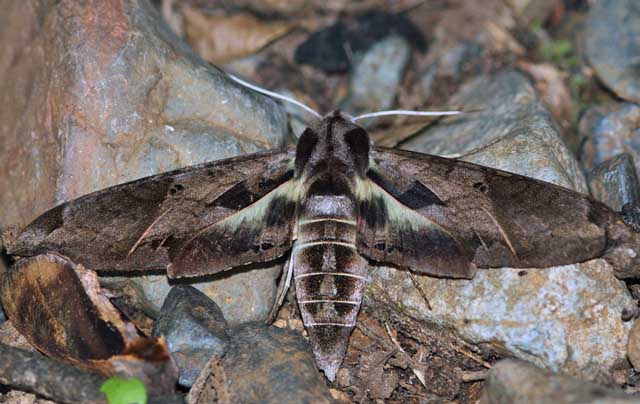Philampelini
 |
Eumorpha fasciatus, the Banded Sphinx
Fw ground colour is dark brown with two broad, beige, intersecting transverse bands, one running from the apex to middle
of fw-body juncture, the other running preapically to near midpoint of inner margin. Much thinner beige lines trace the veins
in the post median area.
|
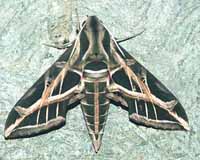 |
Eumorpha vitis
the Vine Sphinx: Forewing is generally quite similar to fasciatus, but note much longer internal extension
of the lowest thin beige post median line into the median area. In fasciatus, this lower thin line in the median area is only a very short dash before meeting
the broad transverse lines. Vitis lacks the broad pink band, found in fasciatus, along the hindwing outer margin.
|
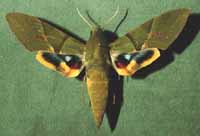 |
Eumorpha labruscae the Gaudy Sphinx:
Fw ground colour bright green to grey-green with a darker triangular median area, delineated by very dark
am line and dark median line.
There is a brownish blotch near midpoint of outer line of darker triangular area, followed
by a beige blotch along the inner margin.
|
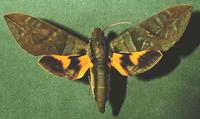 |
Eumorpha phorbas: Fw gc grey-green with series of lighter grey-green bars, dashes, lines:
aml runs straight from costa to i.m.; apical pml runs straight toward intersection of aml and i.m.,
but is broken at about 40% of its course by L-shaped line that turns at about 135 degrees toward aml/im juncture.
|
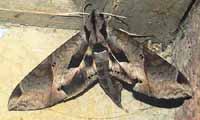 |
Eumorpha satellitia:
Fw i.m., medially with distinct, dark brown rhombiform patch;
area between it and wing base slightly darker than gc; triangular dark patch on i.m. near tornus; less distinct subapical triangular patch on costa;
double black discal spot present; CuA1 conspicuously paler than gc.
|
Eumorpha satellitia, Urruca Lodge, Jorupe National Park, Loja, February 17, 2011, Pia Oberg
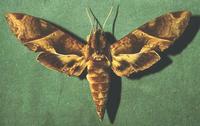 |
Eumorpha anchemolus:
FW outer margin slightly crenulated; similar to E. triangulum, but fw pattern less contrasting and variegated.
Dark subapical costal patch truncated on Rs4. White fringe along inner margin from body to slightly beyond median rhombiform patch very conspicuous.
|
Eumorpha anchemolus, Yasuni, Napo, September 10, 2002, Steve Graser
Eumorpha anchemolus, Napo Wildlife Center (00 31 29 S, 076,26 24 W), 220 meters,
July 4, 2010, photographed by Jean-Paul Lenglet, submitted by Gerard Boula
 |
Eumorpha megaeacus:
Forewing has conspicuous, but ill-defined, pinkish-beige longitudinal band running mostly between CuA1 and CuA2 from wing base,
subparallel to inner margin, to near outer margin.
Below this band, to inner margin, appears a patchwork of patterns.
|
Eumorpha megaeacus: Morona-Santiago
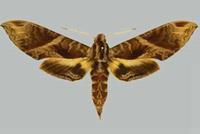 |
Eumorpha cissi: : Similar to anchemolus,
but ground colour: dark greenish-grey; anchemolus: brown. Cissi has more falcate apex.
Cissi lacks strongly contrasting white fringe extending (in anchemolus) from body to slightly past dark rhombiform region.
Two well defined zigzag lines in pale area along i. m. between dark rhombiform region and anal angle.
|
Eumorpha cissi: Morona-Santiago: Macas
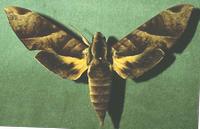 |
Eumorpha obliquus:
Fw: more glossy grey than anchemolus; three straight oblique parallel lines present in basal area running straight from
costal margin to CuP fold; discal spot absent; dark patch near tornus broader than in similar species, rounded triangular;
fringe of posterior margin buff, less extensive than anchemolus.
|
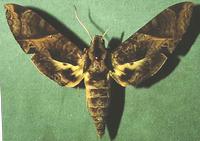 |
Eumorpha triangulum:
Note dark trapezoidal patch emanating from costa just prior to apex. This patch continues into next
intraneural segment, giving triangular appearance; in very similar E. anchemolus same area remains trapezoid without "tailed" extension. Rain forest/cloud forest species unlikely at lower elevations.
|
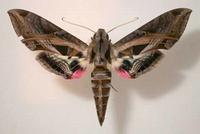 |
Eumorpha drucei:
Dark, trapezoidal, olive patch midway along i.m. sharply pointed toward o.m. along its upper edge. Boldly marked,
orangey veins CuA1, CuA2 have tawny colouration extending toward wing base in pale, slightly arched band. Dark triangular patch near
a.a. extends upward as far as vein CuA1.
Broad pink patch on hw a.a.
|
Eumorpha drucei, Guayaquil
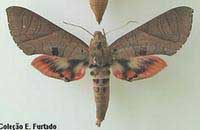 |
Eumorpha adamsi:
Fw: almost uniformly, relatively thin lines, convex outer margin; similar to Eumorpha translineatus,
immediately distinguishable by bright pink marginal band and tornal patch on hindwing. Most pronounced line runs obliquely
from midpoint of costa toward anal angle. questionable in Ecuador
|
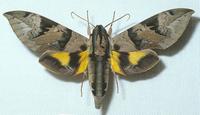 |
Eumorpha capronnieri: Fw ground colour grey to brown
with distinct pattern of mottled green and darker brown areas.
Forewing apex is slightly more
produced and pointed in capronnieri, compared to phorbas.
Note the outward extensions of dark green-brown stripes on abdominal tergites 5 and 6.
|
Eumorpha capronnieri Yasuni, Napo, Ecuador, September 6, 2002 - 9:33 PM, Steve Graser.
|
